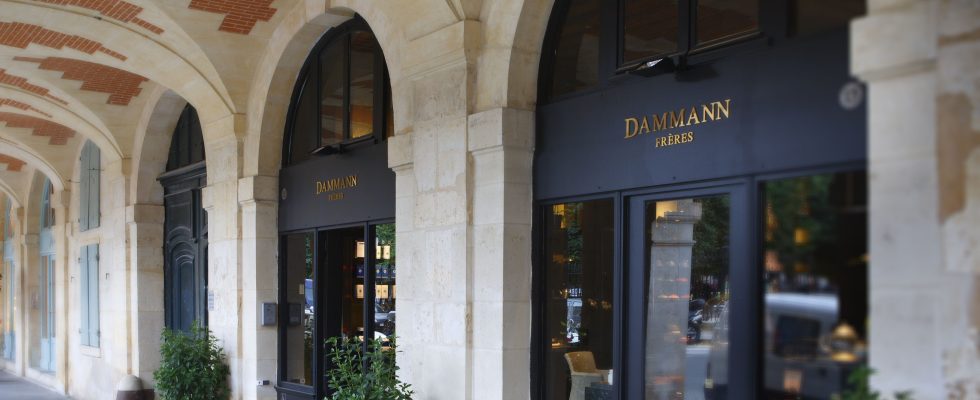As soon as you cross the threshold, a sweet smell tickles the visitor’s nostrils. Because the head office of Dammann Frères not only houses its offices, but also the production and storage of its 350 references of teas and infusions with 1001 flavors. All in Eure-et-Loir, in Dreux, where the factory was established a decade ago in a building deserted by Philips and its televisions. Here, each year, 1,000 tonnes of dry product from China, Japan or Africa are checked and passed through a sieve before being slipped into bags, small metal boxes or one-kilo packages intended to resellers in 70 countries. Stock and preparation of packages for the online store – 12% of sales – also have their space. “The Dammannzone”, smiles technical director Stéphane Pinard.
If its Drouais history is recent, the roots of the brand go back to Louis XIV, who in 1692 granted an ancestor of Pierre and Robert Dammann the exclusivity of the sale of tea in France. The two brothers developed the business at the beginning of the 20th century, through counters, from the East Indies to New York, before handing over to one of their employees, Jean Jumeau-Lafond. “He was the first to trade in bulk tea in post-war France where people were content to buy bags in England,” says his grandson, Emmanuel Jumeau-Lafond, himself initiated into the profession by his father Jacques. “For around ten years, I just tasted and trained my palate. Then I started buying teas myself.” He travels from producing countries to select the precious leaves directly from traders. Sometimes for very small quantities, as for the noble white Ceylon. “There are no intermediaries. So I am sure of the origin of the goods,” explains this professional, also responsible for “aromatic consistency”. “There are similarities with wine, the aromas are completely different from one plantation to another, and can also vary depending on the harvest and the weather.” Emmanuel Jumeau-Lafond then adapts his purchases to ensure a stable taste for his Assam or Darjeeling blends. Expertise that is even more essential with climate change: drought in Kenya or flooding in India affect harvest volumes, but also their flavor.
For a long time, the company worked behind the scenes, anonymously supplying the big names in delicatessens such as Fauchon or Hédiard. In 2007, Didier Jumeau-Lafond, Emmanuel’s uncle, decided to highlight the brand. He recruited Pierre Merlanchon, who had made sparks at Groupe Flo, Hédiard then Boissier. The new marketing director suggested the idea of opening a first store with the golden brand. It will be in Paris, under the arcades of the Place des Vosges. “The brand had to exist, with a Parisian signature that would make foreign customers dream,” he says. The strategy works. Dammann Frères, with fewer than 200 employees, generates a profit of around 2.5 million euros for sales of 40 million, more than doubled compared to 2007. Enough to satisfy the shareholder, the Illy group. Proof that lovers of Italian coffee and French tea can coexist. More recently, Crédit Agricole also provided capital to Dammann, welcome support with a view to its move in 2025, a few hundred meters away, in an optimized, greener building, with modern architecture mixing bricks and glass roofs. .
A new setting to reach new levels. President Erika Le Noan plans to take off in exports, while France still concentrates three quarters of the activity. “We are going to strengthen Europe, the United States and set out to conquer Asia”, aims the former manager of Illy, who arrived in 2019. The opening of new points of sale, to multiply a network which today has around thirty, will be key. “We can easily envisage 10 to 15 openings per year,” she estimates. Dammann Frères has just opened a store at Galeries Lafayette in Dubai and already has two in Osaka and one in Seoul.
A 300-year-old institution of an ancestral drink, the company is attentive to new trends and relies on the variations of its flavorist, a graduate of Isipca, the Versailles school which trains professionals in perfumery, cosmetics and aromatics. eating. It takes a nose and sharp taste buds to concoct the right mixtures. Hibiscus and beetroot. A hint of ginger. A little astringency, but not too much. Among the house’s great successes, Jardin bleu and its notes of strawberry and rhubarb, or Miss Dammann, with passion fruit. As the end-of-year holidays approach, the workforce has been increased. Crucial season: 40% of the figure occurs between October and December. The special boxes are in preparation, the stocks of Advent calendars are ready: 130,000 copies for the Christmas 2023 version, illustrated by the Pangea designer duo. Beyond this association, Dammann is multiplying partnerships: starred chefs, the king of panettone Christophe Louie, and even the cocktail master, Rémy Savage, who imagined two tea-based recipes. Enough to definitively dust off the image of the infusion. With the idea of reaching a young audience, Dammann has also just created matcha latte “sticks”, these drinks that are as green as they are trendy. The Drouais SME also successfully develops teas to be enjoyed cold, refreshing in summer. A good way to reduce the seasonality of your sales. And its carbon footprint. To the great surprise of its president, the first source of emissions for this mission-driven company turned out to be… consumers’ electric kettles.
